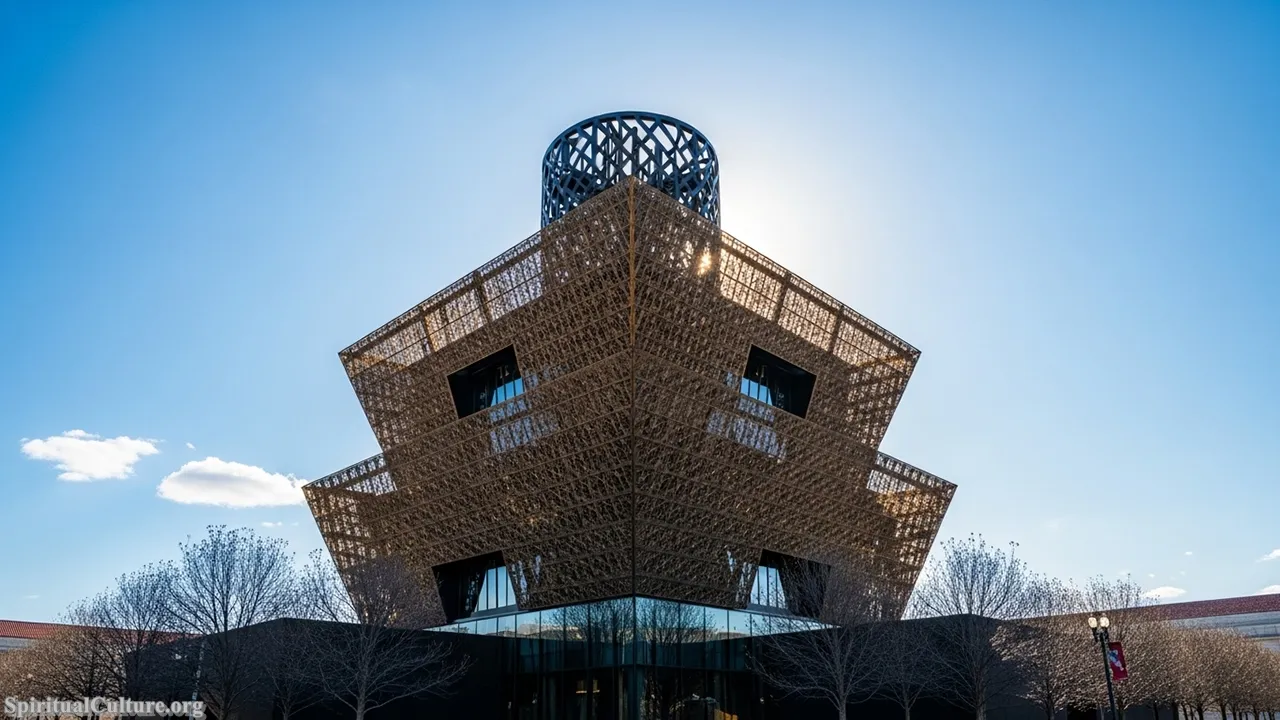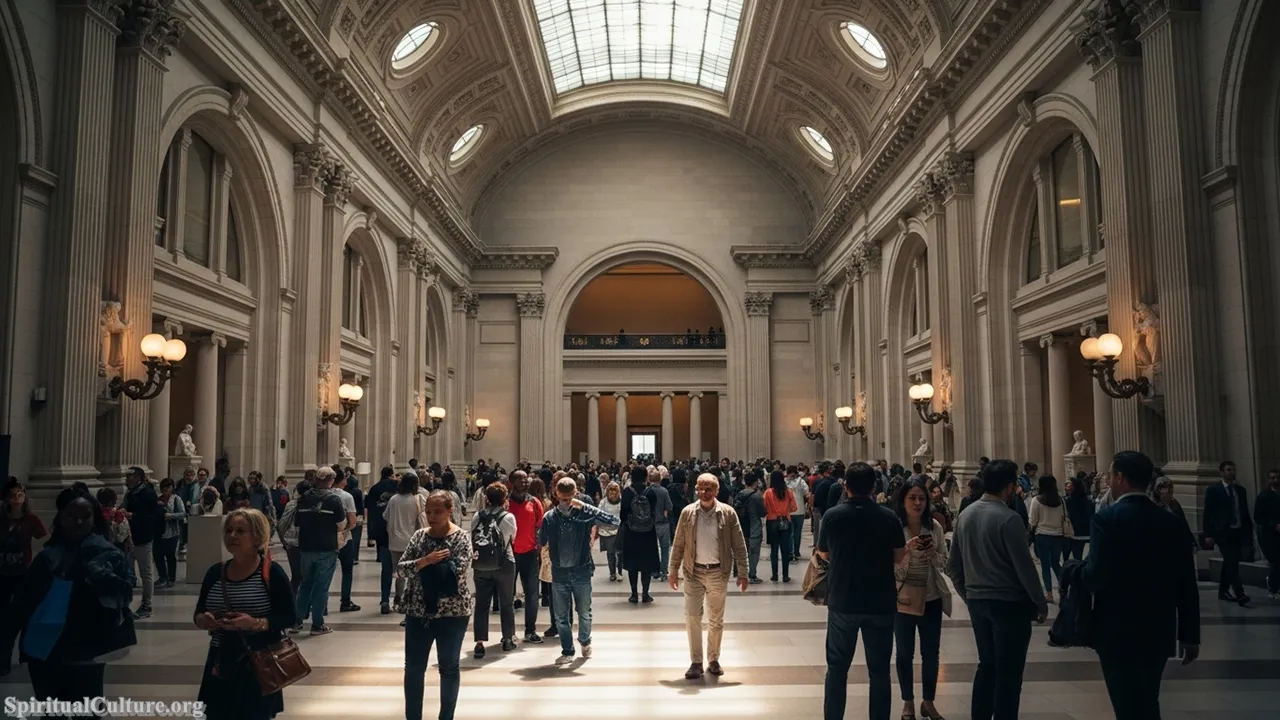Museums are not merely repositories of objects; they are cathedrals of collective memory, offering a sacred space to connect with the deep currents of human history and cultural creation. In the United States, a nation defined by its complexity and diversity, these institutions serve a vital role, curating the story of the nation alongside the grand narrative of global civilization. The most famous museums stand out not just for their collections, but for their profound spiritual and civic impact—inspiring awe, fostering empathy, and challenging visitors to reflect on their place in the universe.
At Spiritual Culture, we believe the true measure of a museum’s greatness lies in its ability to transcend the material and convey the meaning behind the artifact. This ranking considers popularity and visitor numbers, but gives ultimate priority to the depth of cultural context, historical significance, and the palpable spiritual or reflective power of its collections. From the awe-inspiring scope of global art to the hallowed sites preserving moments of national reckoning, these museums offer transformative journeys.
The cultural landscape of the United States, as evidenced by this list in the Current Time of Writing, is defined by institutions that chronicle both the American experiment and the global human experience. They are essential pilgrimage sites for anyone seeking to understand the spiritual roots of innovation, creativity, conflict, and resilience. This is our guide to the Top 10 most influential cultural and spiritual museums in the US.
Table of the Top 10 US Museums by Cultural and Spiritual Influence
| Rank | Museum Name | Location | Primary Focus/Significance | Est. Annual Visitors (Approx.) |
|---|---|---|---|---|
| 1 | The Metropolitan Museum of Art (The Met) | New York, NY | Encyclopedic Art (5,000 years of global culture) | 5.7 million (2024 est.) |
| 2 | Smithsonian National Museum of Natural History | Washington, D.C. | Natural History, Anthropology, Earth Science | 3.9 million (2024 est.) |
| 3 | Smithsonian National Museum of American History | Washington, D.C. | American Social, Political, and Cultural History | 2.1 million (2024 est.) |
| 4 | National Museum of African American History and Culture (NMAAHC) | Washington, D.C. | African American History, Culture, and Life | 1.6 million (2024 est.) |
| 5 | National September 11 Memorial & Museum | New York, NY | Memory, Remembrance, and Impact of 9/11 | 2.4 million (2024 est.) |
| 6 | Art Institute of Chicago | Chicago, IL | World-renowned collection of Impressionist and Post-Impressionist Art | 1.3 million (2024 est.) |
| 7 | United States Holocaust Memorial Museum (USHMM) | Washington, D.C. | Holocaust Remembrance and Historical Documentation | 1.7 million (Pre-Pandemic est.) |
| 8 | American Museum of Natural History (AMNH) | New York, NY | Human Evolution, Astronomy, and Biodiversity | 3.9 million (2024 est.) |
| 9 | National Gallery of Art (NGA) | Washington, D.C. | Western Art from the Middle Ages to the Present | 3.9 million (2024 est.) |
| 10 | National Civil Rights Museum at the Lorraine Motel | Memphis, TN | Civil Rights Movement History (Site of MLK Jr. assassination) | 300,000+ (Highly significant site) |
Top 10. National Civil Rights Museum at the Lorraine Motel
Located at the very site where Dr. Martin Luther King Jr. was assassinated, the National Civil Rights Museum in Memphis transcends a traditional exhibition space; it is a profound monument to the struggle for human dignity. By preserving the historic Lorraine Motel, the museum immediately situates visitors in the heart of the American Civil Rights Movement, utilizing the raw, tangible history of the location to tell the story of resistance, perseverance, and sacrifice. The exhibits meticulously trace the journey from early slavery and reconstruction through the dramatic sit-ins, boycotts, and marches of the 20th century, culminating in the tragic and transcendent moment of Dr. King’s death.

This institution earns its place not for the size of its collection, but for its singular, powerful spiritual impact as a sacred ground of memory and moral reflection. It is an act of pilgrimage for many, a place to confront the deepest moral wounds of the nation and draw inspiration from the spiritual conviction of the movement’s leaders. The reason for its high ranking is the unparalleled resonance of the physical space itself—the preserved balcony and rooms serve as a direct, visceral link to the past, making the lessons of justice and equality immediate and intensely personal.
The museum stands as an enduring lesson in the spiritual principle of nonviolent struggle and the long, arduous road to true equality. Its preservation ensures that the moral imperative of the Civil Rights era remains alive, constantly challenging the current generation to uphold the ideals of justice and compassion. To walk these halls is to commit oneself anew to the task of building a more just and loving world, recognizing the spiritual courage required for true societal change.
Cultural/Spiritual Highlights:
- The exact balcony and rooms (306 and 307) where Dr. Martin Luther King Jr. spent his final hours are preserved and viewable.
- Features comprehensive exhibits on the Brown v. Board of Education ruling, the Montgomery Bus Boycott, and the Freedom Riders.
- The structure serves as one of the most significant sites of modern American moral history and political martyrdom.
Top 9. National Gallery of Art (NGA)
The National Gallery of Art, situated on the National Mall in Washington, D.C., is the nation’s premier collection of Western art, spanning from the Middle Ages to the present day. Endowed to the American people and operating as a gift to the nation with free admission, it democratizes access to masterpieces that trace the spiritual and cultural evolution of humanity. From the serene religious iconography of the Renaissance masters to the vibrant secular explorations of the Impressionists, the NGA’s collection provides a comprehensive visual dialogue on the human experience, making it a cornerstone of American cultural life.

The spiritual impact of the NGA lies in its capacity for pure aesthetic elevation and its role as a secular temple dedicated to human creativity. It holds the only painting by Leonardo da Vinci in the Americas and features works that were once central to the devotional practices of past societies. The reason for its ranking is its authoritative scope and the contemplative atmosphere it fosters; visitors engage in quiet contemplation with pieces that have defined civilization’s understanding of beauty, God, and the self for centuries. The encounter with great art is inherently spiritual, offering moments of profound connection and emotional catharsis.
The NGA reflects the deep-seated human need for beauty, meaning, and transcendence, demonstrating that culture itself is a spiritual endeavor. Its commitment to free access ensures that the collective artistic heritage of the West is not limited by economic barriers, upholding the value that the appreciation of beauty is a fundamental human right. It encourages us to find the divine spark in the human capacity for creation, celebrating art as a vehicle for understanding life’s mysteries.
Cultural/Spiritual Highlights:
- Houses the only Leonardo da Vinci painting in the Americas, Ginevra de’ Benci.
- Its commitment to free admission embodies the democratic principle of accessible cultural enrichment.
- The collection includes masterworks of religious art, offering insight into the spiritual foundations of Western civilization.
Top 8. American Museum of Natural History (AMNH)
Located in New York City, the American Museum of Natural History is a monumental institution dedicated to exploring the diversity of the natural world, human evolution, and the cosmos. Its iconic halls, featuring massive dinosaur skeletons, world-famous habitat dioramas, and the Hayden Planetarium, curate a narrative that spans $13.8$ billion years, from the Big Bang to the present. The AMNH is a global leader in scientific research and education, positioning humanity within the vast, awe-inspiring scope of biological and cosmic time.

The spiritual value of AMNH rests on its ability to evoke a deep sense of humility and wonder—what can only be described as a naturalistic form of awe. Its core mission—the diffusion of knowledge—provides a powerful, evidence-based creation narrative that contrasts with, yet often complements, theological stories. The reason for its ranking is its capacity to place the visitor in a context far larger than their individual life, prompting a profound existential reflection on life, death, and the vast, intricate web of existence. Standing beneath the colossal blue whale or next to a T-Rex skeleton offers a direct, humbling experience of deep time.
This institution is a testament to the human drive for scientific inquiry, reflecting the spiritual quest to understand origins and our interconnectedness with all life. It highlights the ethical imperative of environmental stewardship by showcasing the planet’s fragile biodiversity. The AMNH encourages a reflective understanding of our temporary yet precious existence, fostering a spiritual connection to the Earth and the cosmos.
Cultural/Spiritual Highlights:
- The famed “Deep Time” exhibits house one of the world’s most impressive collections of dinosaur fossils, including the $T.\ rex$.
- The Rose Center for Earth and Space presents a comprehensive, awe-inspiring view of the cosmos and our place in it.
- World-renowned dioramas beautifully illustrate the biodiversity of Earth, promoting ecological reverence and understanding.
Top 7. United States Holocaust Memorial Museum (USHMM)
The United States Holocaust Memorial Museum in Washington, D.C., stands as the nation’s permanent memorial to the victims of the Holocaust. Designed as a “living memorial” to inspire a global conscience, the USHMM is not a conventional museum but a wrenching, powerful historical testimony built upon meticulous documentation and personal accounts. Its architecture and exhibits are designed to evoke the grim journey of those persecuted, ensuring that the history of this unprecedented tragedy is confronted directly and never forgotten.

The museum’s spiritual impact is arguably the most intense on this list, serving as a modern-day moral and ethical pilgrimage site. The reason for its high ranking is its absolute devotion to bearing witness and inspiring visitors to challenge hatred and indifference in their own lives. It elevates memory into a sacred duty, demanding that visitors reflect on the catastrophic failures of humanity and the resilience of the human spirit in the face of unimaginable evil. This is not a place for passive viewing; it is a profound, life-altering call to moral action.
The USHMM is a powerful embodiment of the preservation value, using history to teach eternal lessons about human rights, democratic values, and the danger of unchecked prejudice. It memorializes the tragedy not just to grieve, but to fortify the human spirit against future atrocities, upholding the principle that silence in the face of suffering is complicity. Its existence is a spiritual vow to the deceased: Never Again.
Cultural/Spiritual Highlights:
- The “Hall of Remembrance” provides a dedicated space for reflection and quiet contemplation.
- Features authentic artifacts, including rail cars used for deportations, creating a visceral historical connection.
- Its mission is explicitly moral, seeking to confront hatred, prevent genocide, and uphold human dignity globally.
Top 6. Art Institute of Chicago
Guarded by the iconic bronze lions on Michigan Avenue, the Art Institute of Chicago (AIC) is one of the oldest and largest art museums in the United States, celebrated worldwide for the exceptional quality and breadth of its collection. While its holdings span millennia, the AIC is most famous for its extraordinary collection of Impressionist, Post-Impressionist, and American Art, which includes touchstones like Grant Wood’s American Gothic and Georges Seurat’s A Sunday on La Grande Jatte. This museum is a cultural anchor of the Midwest, serving a vast populace with its encyclopedic view of global art history.

The spiritual dimension of the AIC lies in its deep and focused commitment to the human visual story, particularly the revolutionary shift in perception captured by the late 19th and early 20th centuries. The reason for its ranking is the immense power of its key masterpieces to transport the viewer to other places and times, offering moments of transcendent beauty that border on the sacred. To stand before Van Gogh’s The Bedroom or Monet’s stacks is to witness an artist’s spiritual interpretation of light and form, a momentary glimpse into the eternal through the lens of human genius.
The collection serves as a vital affirmation of creative freedom and the evolving nature of human expression, embodying the moral lesson that innovation is a constant spiritual pursuit. The preservation of these revolutionary works ensures that future generations can access the moment Western art shattered tradition and began an intense, introspective dialogue with the modern world. The AIC is a sanctuary for the spirit of inquiry and the perpetual yearning for self-expression.
Cultural/Spiritual Highlights:
- Home to iconic works that define American identity, such as Grant Wood’s American Gothic.
- Features a world-class collection of Asian art, including significant Buddhist and Hindu sculptures.
- The Thorne Miniature Rooms offer a unique, meditative view into the design and domestic life of past eras.
Top 5. National September 11 Memorial & Museum
The National September 11 Memorial & Museum in New York City is a solemn site dedicated to honoring the 2,983 people killed in the 2001 and 1993 attacks and exploring the global impact of these events. The Memorial consists of twin reflecting pools set within the footprints of the original Twin Towers, serving as a powerful, calming visual monument to absence. The Museum beneath provides a meticulously curated narrative of the attacks, the immediate aftermath, and the enduring legacy of loss and resilience, using artifacts and personal accounts to tell the human story.

The spiritual impact of this museum and memorial complex is profound, functioning as hallowed ground where the sheer scale of the tragedy meets intimate personal memory. The reason for its high ranking is its unique status as a site of national and global trauma, demanding a collective and spiritual act of remembrance. Visitors engage with the artifacts and stories—such as the “Last Column”—in an atmosphere of hushed reverence, reflecting on themes of heroism, fragility, and the unity that emerged from shared grief. It is a modern-day pilgrimage that transcends religious boundaries to affirm the core human values of community and perseverance.
The preservation of this site is a powerful moral lesson in resilience, demonstrating humanity’s capacity to rebuild both physically and spiritually after destruction. It reminds the global community of the sacred value of peace and the imperative to defend democratic values against extremism. The museum’s reflective space encourages visitors to leave with a renewed commitment to empathy and a celebration of the lives lost.
Cultural/Spiritual Highlights:
- The “Reflecting Pools” are profound, meditative symbols of absence and memory.
- The “Last Column” is preserved, covered in signatures and memorials by rescue workers, as a powerful artifact of sacrifice.
- The museum focuses on the concept of human resilience, providing hope alongside remembrance.
Top 4. National Museum of African American History and Culture (NMAAHC)
The National Museum of African American History and Culture (NMAAHC) in Washington, D.C., is the only national museum exclusively dedicated to the documentation of African American life, history, and culture. Since its opening, it has become an immediate and essential cultural touchstone, with a collection of over 40,000 artifacts that span the history of slavery, the Civil Rights Movement, and the immense contributions to American arts, science, and society. The building’s unique “corona” architecture, inspired by Yoruba art and a crown used in Southern ironwork, symbolically ties the African diaspora to American soil.

The spiritual impact of the NMAAHC is rooted in its role as a monumental act of recognition and healing, giving full and central voice to a narrative often relegated to the margins. The reason for its ranking is the deeply moving, chronological journey it offers, which begins below ground in the era of slavery and rises toward the light of the upper-level culture galleries. This ascent symbolizes the spiritual triumph over adversity and the persistent striving for freedom and self-definition. It is a space of necessary confrontation, but ultimately, one of profound celebration, affirmation, and communal spiritual strength.
The museum serves as a critical moral lesson for the nation, emphasizing that true spiritual and civic health requires the acknowledgement and celebration of all its people’s histories. The sheer volume of recovered and preserved artifacts offers a powerful counter-narrative to historical omission, demonstrating the enduring spiritual creativity and unbreakable will of a people. It is a testament to the preservation of culture in the face of erasure.
Cultural/Spiritual Highlights:
- The architecture, particularly the three-tiered corona, symbolically links African and African American art traditions.
- Exhibits include a segregated Southern Rail Car and historical objects related to Harriet Tubman.
- The “Contemplative Court” offers a water-filled, silent space for reflection on the historical journey.
Top 3. Smithsonian National Museum of American History
As the primary custodian of the nation’s tangible memory, the Smithsonian National Museum of American History on the National Mall chronicles the social, political, cultural, scientific, and military history of the United States. Its vast collections range from the original Star-Spangled Banner to Dorothy’s ruby slippers and Julia Child’s kitchen, making it the definitive cultural repository for the American experience. This museum attempts to capture the sprawling, complex, and often contradictory story of America—the ideals of liberty alongside the realities of conflict and progress.

The spiritual significance of this museum lies in its function as the ultimate civic memory, fostering a shared sense of identity and encouraging a reflective, often challenging, examination of what it means to be American. The reason for its ranking is its immense cultural breadth and its capacity to connect visitors to the foundational moments and figures of the nation. To view the original flag that inspired the national anthem is a profound, goose-pimple-inducing moment of civic pilgrimage, linking the individual to the nation’s soul and its ongoing spiritual experiment in democracy.
This institution reinforces the value of preserving the artifacts of democracy, from the smallest domestic object to the grandest political symbol. It teaches the moral lesson that a nation’s history is a living, evolving narrative that must be continually examined for its truths and its failings. By preserving the objects of innovation and everyday life, it celebrates the ingenuity and resilience of the American spirit.
Cultural/Spiritual Highlights:
- Home to the original Star-Spangled Banner, a powerful symbol of national identity and resilience.
- The First Ladies Collection showcases the evolving spiritual and social role of women in American public life.
- Exhibits detail critical civic and moral struggles, including the Civil Rights movement and industrial labor history.
Top 2. Smithsonian National Museum of Natural History
A central pillar of the Smithsonian Institution in Washington, D.C., the National Museum of Natural History is one of the most visited museums in the world, dedicated to the study of the Earth, its inhabitants, and the evolution of human culture. Its $146$ million specimens and artifacts span geology, anthropology, botany, and zoology, providing a comprehensive, research-backed chronicle of the natural world. From the mysteries of the deep ocean to the origins of our earliest ancestors, the museum offers an unparalleled educational journey through the history of life.

The spiritual dimension of the Natural History Museum is centered on the concept of cosmic and biological awe. It earns its high ranking because it powerfully situates the visitor in the grandest possible narrative: the $3.7$ billion-year story of life on Earth. The spectacular collections, such as the Hope Diamond and the “Deep Time” fossil hall, are not just beautiful objects; they are sacred scientific relics that force a reflective confrontation with the profound mysteries of existence, scale, and time. It is a universal cathedral of science, accessible to all, providing a foundational understanding of our shared planet.
The institution’s mission highlights the preservation value of our planet’s natural heritage and the moral obligation to understand and protect it. By showcasing human origins and global cultures, it fosters an appreciation for the unity of the human species, reinforcing the spiritual truth that we are all part of one continuous, incredible story. The museum serves as an essential reminder of the fragility and wonder of the world we inhabit.
Cultural/Spiritual Highlights:
- Home to the legendary 45.52-carat Hope Diamond, an object of immense geological and cultural fascination.
- The David H. Koch Hall of Fossils – Deep Time, provides a profound evolutionary and geological narrative.
- Vast anthropology exhibits explore the origins and diversity of global human cultures, fostering cross-cultural empathy.
Top 1. The Metropolitan Museum of Art (The Met)
The Metropolitan Museum of Art, affectionately known as “The Met,” stands as the definitive cultural institution of the United States and one of the most comprehensive museums in the world. Located on Fifth Avenue in New York City, its collections span 5,000 years of global human history, encompassing virtually every medium of art and culture from every part of the world. It is an encyclopedic temple of creativity, housing the artifacts of countless civilizations, from ancient Egyptian temples to contemporary masterworks, all under a single, iconic roof.

The Met’s singular spiritual impact comes from its sheer, overwhelming breadth, positioning it as the ultimate sanctuary for global cultural heritage. The reason for its top ranking is that it functions as a spiritual pilgrimage site to humanity itself; a place where one can walk from the Temple of Dendur (2,000 years old) to a Vermeer painting (400 years old) to a recent Pollock (70 years old) in a matter of minutes. This journey through time and culture fosters an unparalleled reflective experience on the unity and continuity of the human spiritual quest for meaning and beauty, regardless of geography or era.
The preservation of such an immense and diverse collection serves as a moral lesson in cultural stewardship and a celebration of human genius as a universal, transcendent force. The Met teaches us that all cultures, across all time periods, are interconnected chapters in one grand spiritual book. It is a confident, warm, and profound space that inspires visitors to recognize the shared heritage and spiritual potential of every civilization.
Cultural/Spiritual Highlights:
- Houses the Temple of Dendur, a fully intact 1st-century Egyptian temple, acting as a living shrine.
- Features comprehensive collections of religious art, including Buddhist, Christian, and Islamic traditions.
- The American Wing contains period rooms that are themselves immersive historical and cultural experiences.
Conclusion
The great museums of the United States, as highlighted by this Spiritual Culture guide, are more than tourist attractions; they are sacred institutions dedicated to the preservation of human memory and the celebration of the soul’s creative impulse. From the contemplative hush of the National September 11 Memorial to the colossal sweep of cosmic history at the American Museum of Natural History, each institution offers a unique path to reflection and understanding. These cultural anchors provide the context necessary for a spiritual life grounded in history and illuminated by creativity.
In the Current Time of Writing, as society navigates complexity, the value of these repositories—which teach us about resilience, the quest for justice, and the enduring beauty of art—is immeasurable. They are places where the past speaks to the present, reminding us of our shared humanity and inspiring the spiritual culture we must build for the future. We encourage everyone to undertake the pilgrimage to these great houses of history and art, and to draw inspiration from the spiritual impact of the greatness preserved within their walls.




